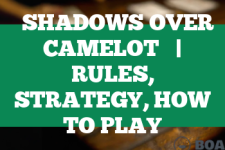Janggi (Korean Chess): The Ultimate Guide to Mastering Strategy, Winning and Rules
Introduction
Janggi, also known as Korean chess, is a strategic board game that has been played for centuries. It is similar to the international chess game, but with its unique rules and strategies. The game is played on a board divided into a 9×10 grid, with each player controlling a set of pieces. The objective of the game is to checkmate the opponent’s king, just like in international chess. The history of Janggi dates back to the Three Kingdoms period in Korea, making it a game rich in cultural heritage. To play Janggi, you need a Janggi board and a set of Janggi pieces.

Rules for playing Janggi
The rules of Janggi are quite different from those of international chess. Here are the basic rules:
- Each player starts with 16 pieces: one king, one guard, two horses, two chariots, two cannons, two elephants, and five soldiers.
- The game begins with the blue pieces (or the pieces with Chinese characters) making the first move.
- Each piece has its own unique movement pattern. For example, the king can only move one step at a time, while the chariot can move any number of steps horizontally or vertically.
- The game ends when one player checkmates the opponent’s king. This is achieved by positioning pieces so that the king is threatened with capture (‘check’) and there is no way to remove the threat on the next move (‘checkmate’).
There are also some ‘house rules’ that can be used to add variety to the game. For example, some players allow the king to move more than one step at a time, or allow the soldiers to move backwards.
How do you play Janggi (Korean chess)
Playing Janggi involves three main stages: setup, gameplay, and end of the game.
- Setup: The pieces are arranged on the board in a specific pattern. The king is placed in the center of the first row, with the guard next to it. The chariots are placed on the corners of the board, and the soldiers are placed on every other square in the third row.
- Gameplay: Players take turns moving their pieces, trying to capture the opponent’s pieces and checkmate the king. The unique movement patterns of the pieces add a layer of strategy to the game.
- End of the Game: The game ends when one player checkmates the opponent’s king. If neither player can achieve this, the game ends in a draw.
How each piece in Janggi moves
1. King: The King moves one step at a time in any direction, but is confined within his palace, which is a 3×3 space in the center of the player’s side of the board.
2. General: In Janggi, there’s only one general and it’s the opponent’s king. The general has the same moving pattern as the king.
3. Guards: The Guards also move one step at a time in any direction but are confined to the palace. There are two guards in the game.
4. Horses: The Horse moves one step straight in any direction, and then one step diagonally outward. The horse’s movement can be blocked if a piece is placed in the first step of its path.
5. Elephants: The Elephant moves one step straight in any direction, and then two steps diagonally outward. The elephant’s movement can be blocked if a piece is placed in the first step of its path.
6. Chariots: The Chariot moves any number of steps horizontally or vertically across the board. It cannot jump over other pieces.
7. Cannons: The Cannon moves like the chariot, any number of steps horizontally or vertically. However, to capture, it must jump over exactly one other piece (of either color).
8. Soldiers: Soldiers move and capture by moving one step forward. However, once they cross the river (the middle line of the board), they can also move and capture one step to the side. Soldiers do not promote upon reaching the end of the board.
Remember, the goal of Janggi is to checkmate the opponent’s king, similar to conventional chess.
How to Win at Korean chess
Winning at Janggi requires a combination of strategic planning, tactical execution, and a deep understanding of the game’s rules and piece movements. Here are some strategies that can help you win:
- Control the Center: Just like in international chess, controlling the center of the board gives you more mobility and options. Try to position your chariots and cannons in the center to control the game.
- Use Your Pieces Effectively: Each piece has its own strengths and weaknesses. For example, the chariot is powerful and versatile, but it can be vulnerable if left unprotected. The cannon is unique in that it jumps over one piece to capture another, making it a powerful offensive weapon.
- Protect Your King: Your king is your most important piece. Always keep it protected and avoid unnecessary risks.
Remember, practice makes perfect. The more you play, the better you will become at spotting opportunities and avoiding pitfalls.
Best Strategies for playing Janggi (Korean chess)
Mastering Janggi requires not only understanding the rules, but also developing effective strategies. Here are some of the best strategies for playing Janggi:
- Develop Your Pieces Early: In the opening stages of the game, try to develop your pieces quickly and efficiently. This means moving your pieces to positions where they can control the board and support each other.
- Plan Ahead: Always think a few moves ahead. Try to anticipate your opponent’s moves and plan your strategy accordingly.
- Be Flexible: Don’t stick to a single strategy. Be ready to adapt your strategy based on the situation on the board.
Remember, the key to winning at Janggi is to outthink your opponent. Always stay one step ahead and keep your opponent guessing.
Scenarios for Janggi
There are many scenarios that can occur in a game of Janggi. Here are some common scenarios and how to handle them:
- Checkmate Threat: If your king is threatened with checkmate, you need to act quickly to remove the threat. This can be done by moving your king, capturing the threatening piece, or placing one of your own pieces between your king and the threatening piece.
- Piece Advantage: If you have more pieces than your opponent, you have a piece advantage. Use this advantage to control the board and pressure your opponent.
- Stalemate: If neither player can checkmate the other, the game ends in a stalemate. In this scenario, the player with more pieces usually has the advantage.
Remember, every scenario is an opportunity to learn and improve. The more scenarios you encounter, the better you will become at handling them.
Frequently Asked Questions about playing Janggi (Korean chess) game
- Q: How many pieces does each player start with in Janggi?
A: Each player starts with 16 pieces: one king, one guard, two horses, two chariots, two cannons, two elephants, and five soldiers. - Q: Who makes the first move in Janggi?
A: The player with the blue pieces (or the pieces with Chinese characters) makes the first move. - Q: Can the king move more than one step at a time?
A: According to the official rules, the king can only move one step at a time. However, some players use ‘house rules’ that allow the king to move more than one step. - Q: What happens if neither player can checkmate the other?
A: If neither player can checkmate the other, the game ends

Eve Brownlee was a gamer before gaming communities on the internet were a thing. Eve grew up playing traditional, standard deck card games like Rummy and Bezique, taking an interest in the classics Backgammon and Chess. Parlor card games like Bridge continue to keep Eve active in the community. After a long career, primarily in horticulture for USDA in Maryland, Eve now travels and writes on The Pineapple (pineapples.info) and contributes to Quora/Pinterest topics. Contact Eve via email.



